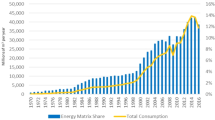This paper shows how local spatial nonparametric prediction models can be applied to estimate volumes of recoverable gas resources at individual undrilled sites, at multiple sites on a regional scale, and to compute confidence bounds for regional volumes based on the distribution of those estimates. An approach that combines cross-validation, the jackknife, and bootstrap procedures is used to accomplish this task. Simulation experiments show that cross-validation can be applied beneficially to select an appropriate prediction model. The cross-validation procedure worked well for a wide range of different states of nature and levels of information. Jackknife procedures are used to compute individual prediction estimation errors at undrilled locations. The jackknife replicates also are used with a bootstrap resampling procedure to compute confidence bounds for the total volume. The method was applied to data (partitioned into a training set and target set) from the Devonian Antrim Shale continuous-type gas play in the Michigan Basin in Otsego County, Michigan. The analysis showed that the model estimate of total recoverable volumes at prediction sites is within 4 percent of the total observed volume. The model predictions also provide frequency distributions of the cell volumes at the production unit scale. Such distributions are the basis for subsequent economic analyses.










Similar content being viewed by others
Notes
The use of rank correlations to introduce dependence when summing random variables is similar to a scheme developed by Schuenemeyer (1999) to aggregate petroleum play simulations where the plays are assumed to be geologically dependent.
The introduction of the dependency requires the re-centering of the distribution of the replicates about the prediction value. The bias-correction procedure described in Efron and Gong (1983) was used to recenter the replicate distribution about the model prediction estimate as if it were the median of the distribution.
References
Department of Environmental Quality of the State of Michigan, 2003a, Production of oil and gas wells database, 1981–1990 production: Lansing, Michigan, Office of Geological Survey [Michigan], downloaded November 3, 2005 from URL http://www.michigan.gov/deq
Department of Environmental Quality of the State of Michigan, 2003b, Production of oil and gas wells database, 1991–2000 production: Lansing, Michigan, Office of Geological Survey [Michigan], downloaded November 3, 2005 from URL http://www.michigan.gov/deq
Department of Environmental Quality of the State of Michigan, 2005a, Production of oil and gas wells database, 2001–2003 production: Lansing, Michigan, Office of Geological Survey [Michigan], downloaded November 3, 2005 from URL http://www.michigan.gov/deq
Department of Environmental Quality of the State of Michigan, 2005b, Production of oil and gas wells database, 2004–2005 production: Lansing, Michigan, Office of Geological Survey [Michigan], downloaded November 3, 2005 from URL http://www.michigan.gov/deq
Efron, B., and Gong, G., 1983, A leisurely look at the bootstrap, the jacknife, and cross-validation: American Statistician, v. 37, no. 1, p. 36–48.
Gautier, D. L., Dolton, G. L., Takahashi, K. I., and Varnes, K. L., eds., 1996, 1995 National assessment of United States oil and gas resources—results, methodology, and supporting data: U.S. Geol. Survey Digital Data Series 30, version 2 corrected.
Hastie, T., Tibshirani, R., and Friedman, J., 2001, Elements of statistical learning: Springer, New York, 531 p.
Iman, R. L., and Conover, W. J., 1982, A distribution free approach to inducing rank correlation among input variables: Communications in Statistics—Simulation and Computation, v. 11, no. 3, p. 311–334.
Lahiri, S. N., 2003, Re-sampling methods for dependent data: Springer, New York, 374 p.
Miller, R. G., 1964, A trustworthy jackknife: Annals Math. Statistics, v. 35, no. 4, p. 1594–1605.
Miller, R. G., 1974, The jackknife—a review: Biometrika, v. 62, no. 1, p. 1–15.
Schuenemeyer, J. H., 1999, Methodology, in The oil and gas potential of the 1002 Area, Arctic National Wildlife Refuge, Alaska: U.S. Geol. Survey Open File Rept. 98-34, CDROM.
Stone, C. J., 1977, Consistent nonparametric regression (with discussions): Annals Statistics, v. 5, no. 4, p. 595–645.
Swezey, C. S., 2005, The U.S. Geological Survey oil and gas assessment of the Michigan Basin, in: Part II—Undiscovered Oil and Gas in the Michigan Basin: Michigan Petroleum Technology Transfer Council (PTTC) Workshop (Mount Pleasant, Michigan; October 20, 2005), p. 6–79.
Tomczak, M., 1998, Spatial interpolation and its uncertainty using automated anisotropic inverse distance weighting (IDW)—cross-validation/jackknife approach: Jour. Geographic Information and Decision Analysis, v. 2, no. 2, p. 18–30.
Tukey, J. W., 1958, Bias and confidence in not large samples (abst.) Annals Math. Statistics, v. 29, p. 614.
Yatchew, A., 1998, Nonparametric regression techniques in economics: Jour. Economic Literature, v. 36, no. 2, p. 669–721.
Author information
Authors and Affiliations
Corresponding author
Appendices
Appendix A. Generation of the states of nature
The states of nature were generated to fill a spatial area representing a grid of 40 by 40 cells or 1600 total cells. Initially, a lognormal distribution with a mean of 0.5 and variance of 1 was sampled 1600 times. Figure A-1 is the frequency recovery size distribution of the 1600 volumes that were sampled. These cell recovery volumes represent the resource endowment of each state of nature. The random state of nature (see Fig. 1A) was generated by randomly assigning volumes to cells. The other specifications of the states of nature amounted to a rearrangement of the cell volumes to mimic common geologic structures. Total volume represented in Figure A-1 and in Figures 2A, 2B, 2C, and 2D is 802,000 million cubic feet of gas or equivalently 802 billion cubic feet of gas.
Appendix B
Box plot Figures B-1 and B-2 for the simulation experiments for the various states of nature for training sample samples at 160 and 400 sites where gas resource recovery is assumed known.
Rights and permissions
About this article
Cite this article
Attanasi, E.D., Coburn, T.C. & Freeman, P.A. Prediction of Resource Volumes at Untested Locations Using Simple Local Prediction Models. Nat Resour Res 15, 223–239 (2006). https://doi.org/10.1007/s11053-007-9027-8
Published:
Issue Date:
DOI: https://doi.org/10.1007/s11053-007-9027-8




